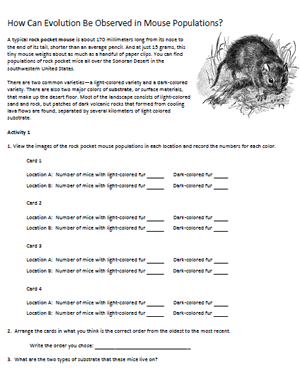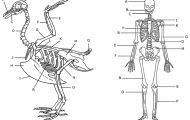

Explain why a rock pocket mouse’s color influences its overall fitness. You may recordĪll of your data for each time period (A and B) on one bar graph or split A and B and make two graphs.ġ. Be sure to provide an appropriate title for the graph, and titles and labels for the x- and y-axes. Use colored pencils to prepare a bar graph based on the data that shows the distribution of the mice at locations A and B Once you are satisfied that you are correct, fill out the data table below using the counts you recorded above theĥ.

Using what you learned by watching the film, check the order in which you arranged the illustrations. What can explain the differences among the illustrations?Ĥ. What role does the rock pocket mouse play in the desert food web? How does this trait affect the survival of the mice in different environments? Why are some mice light colored and some mice dark colored?ĭoes fur color provide any selective advantage or disadvantage? What specific trait did researchers study in this investigation? Answer the following as you watch the film: You arranged the illustrations is correct. Watch, look for an explanation for the differences among the illustrations that will help you confirm that the order in which Watch the Howard Hughes Medical Institute’s short film The Making of the Fittest: Natural Selection and Adaptation. Positioned the others in the sequence as you did.ģ. Explain how you decided which illustration represents the most recent rock pocket mouse population and why you Indicate your order in the spaceīelow: _Ģ. Place the illustrations in what you think is the correct order from oldest to most recent. Shows the color variation at two different locations, A and B, at a particular moment in time. The illustrations (The teacher passed out) represents snapshots of rock pocket mouse populations. Volcanic rocks that formed from cooling lava flows are found, separated by several kilometers of light- colored substrate. Most of the landscape consists of light-colored sand and rock, but patches of dark

Materials, that make up the desert floor. There are also two major colors of substrate, or surface There are twoĬommon varieties-a light-colored variety and a dark-colored variety. You can find populations of rock pocket mice all over the Sonoran Desert in the southwestern United States. Rock pocket mice, however, have had an enormous Grams, this tiny mouse weighs about as much as a handful of paper clips. The Google Drive folder is set as “View Only” to save a copy of a document in this folder to your Google Drive, open that document, then select File → “Make a copy.” These documents can be copied, modified, and distributed online following the Terms of Use listed in the “Details” section below, including crediting BioInteractive.Name _ĬOLOR VARIATION OVER TIME IN ROCK POCKET MOUSE POPULATIONSĪ typical rock pocket mouse is about 170 millimeters long from nose to rump, shorter than an average pencil. Not all downloadable documents for the resource may be available in this format. The “Resource Google Folder” link directs to a Google Drive folder of resource documents in the Google Docs format. We would ask that you attribute these to BioInteractive and not use them for commercial purposes. These card images are licensed under a Creative Commons Attribution-NonCommercial-ShareAlike 4.0 International (CCC BY-NC-SA 4.0) license.
#Rock pocket mouse worksheet zip file#
A document within the ZIP file contains suggestions for their use. The “Card Images” ZIP file contains individual image files for the cards used in this activity that can be used in the classroom, particularly in online courses. This activity serves as an extension to the short film The Making of the Fittest: Natural Selection and Adaptation and as a means of reinforcing the concepts of variation and natural selection. The activity involves collecting and graphing data and making evidence-based claims. They then order those images based on the data and their knowledge of evolution by natural selection. Students analyze data from images of rock pocket mouse populations in different settings and over time. This activity allows students to collect and analyze data on the evolution of coat color in rock pocket mouse populations living on differently colored substrates.


 0 kommentar(er)
0 kommentar(er)
